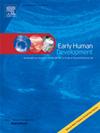The predictive value of maternal inflammation markers for neonatal early-onset sepsis
IF 2
3区 医学
Q2 OBSTETRICS & GYNECOLOGY
引用次数: 0
Abstract
Purpose
Maternal infection is a known risk factor for neonatal early-onset sepsis (EOS). However, the relationship between maternal inflammatory makers near delivery and neonatal EOS remains unclear. This study aimed to evaluate these associations and explore whether maternal blood parameters could contribute to EOS risk assessment strategies.
Methods
In this retrospective multicenter study in Hong Kong, we included mother‑neonate pairs where the mother underwent a complete blood count (CBC) or C-reactive protein (CRP) test between 48 h before and 72 h after delivery from January 1, 2006 to December 31, 2017. We assessed associations between maternal white blood cell count (WCC), absolute neutrophil count (ANC), neutrophil-to-lymphocyte ratio (NLR), platelet-to-lymphocyte ratio (PLR), and CRP with subsequent neonatal EOS.
Results
Among 380,455 mother‑neonate dyads, 460 neonates developed EOS. Markedly elevated maternal WCC, ANC, NLR, and PLR within 24 h before delivery were significantly associated with neonatal EOS, particularly in neonates born at ≥30 weeks' gestation. Within 12 h before delivery, the estimated likelihood ratios (LRs) for WCC > 30 × 10^9/L, ANC > 30 × 10^9/L, NLR > 50, and PLR > 800 were 23.8, 73.1, 45.7, and 45.6, respectively, in neonates born at 30–36 weeks, and 36.4, 92.9, 20.9, and 17.5, respectively, in term neonates. LRs were even higher when markers were elevated earlier (within 24 to 12 h) before delivery, suggesting a temporal relationship between maternal inflammation and neonatal EOS risk.
Conclusions
Although maternal sepsis biomarkers are insufficient to diagnose neonatal EOS independently, their elevation is associated with increased risk and may support clinical risk stratification, particularly when occurring well before delivery.
母体炎症标志物对新生儿早发性败血症的预测价值
目的:母体感染是新生儿早发性脓毒症(EOS)的已知危险因素。然而,分娩前后母体炎症因子与新生儿EOS之间的关系尚不清楚。本研究旨在评估这些关联,并探讨母体血液参数是否有助于EOS风险评估策略。方法在香港进行的这项回顾性多中心研究中,我们纳入了母亲在2006年1月1日至2017年12月31日分娩前48小时和分娩后72小时进行全血细胞计数(CBC)或c反应蛋白(CRP)检测的母婴对。我们评估了产妇白细胞计数(WCC)、绝对中性粒细胞计数(ANC)、中性粒细胞与淋巴细胞比率(NLR)、血小板与淋巴细胞比率(PLR)和CRP与新生儿EOS之间的关系。结果380,455对母婴中,460名新生儿出现EOS。分娩前24小时内母体WCC、ANC、NLR和PLR的显著升高与新生儿EOS显著相关,特别是在妊娠≥30周的新生儿中。在分娩前12小时内,WCC >的估计可能性比(LRs);30 × 10^9/L, ANC >;30 × 10^9/L, NLR >;50, PLR >;30-36周出生的新生儿分别为23.8、73.1、45.7和45.6,足月出生的新生儿分别为36.4、92.9、20.9和17.5。当标志物在分娩前较早(24 - 12小时)升高时,LRs甚至更高,这表明母体炎症与新生儿EOS风险之间存在时间关系。结论:虽然母体败血症生物标志物不足以独立诊断新生儿EOS,但其升高与风险增加有关,可能支持临床风险分层,特别是在分娩前发生时。
本文章由计算机程序翻译,如有差异,请以英文原文为准。
求助全文
约1分钟内获得全文
求助全文
来源期刊

Early human development
医学-妇产科学
CiteScore
4.40
自引率
4.00%
发文量
100
审稿时长
46 days
期刊介绍:
Established as an authoritative, highly cited voice on early human development, Early Human Development provides a unique opportunity for researchers and clinicians to bridge the communication gap between disciplines. Creating a forum for the productive exchange of ideas concerning early human growth and development, the journal publishes original research and clinical papers with particular emphasis on the continuum between fetal life and the perinatal period; aspects of postnatal growth influenced by early events; and the safeguarding of the quality of human survival.
The first comprehensive and interdisciplinary journal in this area of growing importance, Early Human Development offers pertinent contributions to the following subject areas:
Fetology; perinatology; pediatrics; growth and development; obstetrics; reproduction and fertility; epidemiology; behavioural sciences; nutrition and metabolism; teratology; neurology; brain biology; developmental psychology and screening.
 求助内容:
求助内容: 应助结果提醒方式:
应助结果提醒方式:


